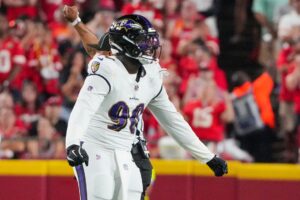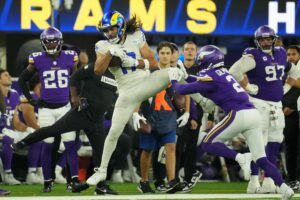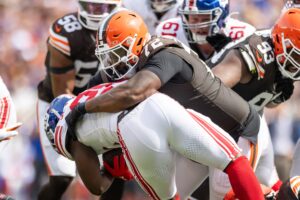The offensive line is point and tangent to the central success of any team. Study the great teams of the turn of the passing era, and a simultaneous cohesion can be found with offensive lines whom succeed. They were the men in trenches, fighting together. Gene Upshaw and Art Shell locked down the Oakland Raiders in Super Bowl XI – Jerry Kramer and Forrest Gregg for the Green Bay Packers in Super Bowl I – Mark Schlereth and Gary Zimmerman of the Denver Broncos. The list can go on and on, but the point stands there was a resounding truth these men fought and grew together.
Despite the current NFL offensive line situation, the Kansas City Chiefs have molded a unit that can tangentially work together thanks to three years of that molding. Offensive line coach Andy Heck has coordinated the starting offensive line to work together; but that coordination is futile unless the men can efficiently block. The duality of pass and run blocking must achieve a level of marginal efficiency to push the Chiefs forward. Through training camp and two pre-season games, the Chiefs offensive line breakdown has revealed both certain truths and points of uncertainty.
Kansas City Chiefs Offensive Line Breakdown – The Truth Behind the Training
Parker Ehinger Returns from the PUP List
Starting off with the best news of recent days, left guard Parker Ehinger has returned from the physically unable to perform (PUP) list after tearing his ACL last season. Ehinger was drafted out of the University of Cincinnati in the fourth round of the 2016 draft with an emphasis to groom him as a starting guard.
Ehinger started last season though four games, and played in five. However, his season ended against the Indianapolis Colts due to the aforementioned ACL injury. The good news for Ehinger is the ACL is no longer a death knell for career trajectory. The bad news is that it set Ehinger back and prevented the Chiefs offensive line from developing true continuity across five positions.
Ehinger will most likely be competing with Bryan Witzmann for the starting left guard position. Witzmann is currently the starting left guard in both the rotation and depth chart, but a competition will occur once Ehinger returns fully healthy.
Competition and Continuity
The Chiefs starting offensive line for the opening of the season, as of August 23rd, looks to be Eric Fisher at left tackle, Bryan Witzmann at left guard, Mitch Morse at center, Laurent Duvernay-Tardif at right guard, and Mitchell Schwartz at right tackle.
The only position that is truly open for competition is left guard. Last year Fisher, Morse, and Schwartz started all 16 games, while Duvernay-Tardif started 14 games, and Fulton started 12 games. Hence, 2017 will be a season largely developed of continuity. However, just because a player has started in one position does not indicate head coach Andy Reid won’t look elsewhere to improve.
Training camp has been emphatically competitive due to the defensive line, specifically Bennie Logan and Alvin Bailey, dominating the offensive line in run and goal line drills. Fulton, Witzmann, Andrew Tiller, and Jah Reid have all seen ample time rotating through. Yet, there is a strange dichotomy developing as none have impressed to truly compete as starting lineman. Thus, competition is a misnomer for what training camp has been for the offensive line less, the left guard position and backups.
Mitch Morse – The Evolving Center
Functionally, the center operates as the general and leader of the offensive line, a second set of eyes for the quarterback. Mitch Morse is the tangential eyes for Alex Smith, and carries the flow of the four men next to him. After two seasons of starting, Morse and Smith have developed an undeniable trust between one another on pass and run protection.
Morse may have the biggest year of growth due to the continuity factor. The center communicates on behalf of the other lineman, and Morse now communicates without needing to speak. Even with Eric Fisher, lined up at tackle two slots down the line, Morse has shown the ability to track linemen when defenses attempt to stunt or roll.
The ability to pass off stunts comes from technique, leverage, pop, and knee bend. Morse rounds out his technique with an understanding of opponents. In the modern NFL, many linemen have worked on their own skill set in a specialized manner, instead of developing a holistic attack style that can adapt to different defensive lines.
NFL meta issues aside, Morse has shown significant development in how he handles leverage against linebackers. In two-man schemes, Morse is by far the best lineman at getting off blocks and pinning linebackers. Schematically, this helps to create holes in the counter rushing game.
However, he still at times gets a bad angle on faster linebackers. In the development of a rushing play, linebackers are drawn to be in a specific place. Not all linebackers will be in the designed place – the Chiefs saw this in Vontaze Burfict, a quicker linebacker who anticipates where to cause disruption. For developmental purposes, Morse needs to grow from imagining a play design to reading where the linebacker truly is (a point that stands for the entire offensive line).
The other movement Morse has perfected is the lateral shuffle. Whether facing 4-3 or 3-4 alignment, Morse is quick enough to shuffle down the line of scrimmage and pick up a blitz or stunting defensive player. The dance of the offensive line is as precise as a ballet, and Morse can quickly shuffle while keeping knee flexion, enabling a strong explosion on the next man he picks up.
I-Formation Troubles
Just as Morse has evolved his technique, so has the offensive line holistically revealed their weaknesses in scheme. As part of limitations to adapt to any defensive line or scheme thrown at the Chiefs offensive line, certain problems have developed in the running game, particularly the I-Formation.
Several times in training camp and pre-season games, the Chiefs have run out of the I-formation; a standard short yardage set where the Chiefs primarily run A or B gap runs. Sweep plays can be run out of the I-formation, but coach Reid has yet to call a sweep play out of this setup.
To successfully win tight formation battles, the offensive line needs to block with preciseness and unison on two levels. First, the defensive line must be thrusted backward no exception. On the run side direction, even if one man gets through, the play is dead. The Chiefs typically accomplish this task.
Second, the defensive line must be thrown into linebackers so the guards can pin their man and then pop linebackers. Out of I-formation, this is where the trouble begins. Whether strength, confidence, or technique is the problem, linebackers run free. Guards Witzmann and Tardif-Duvernay get blown back or stood up. This leaves Morse to assist on every single play. Thus, two players for three linemen.
On most I-formation runs, the tackles will block downward and let the edge rusher run free. (Time and play design negates the edge rusher having the time to make an impact.) Thus, Fisher and Schwartz can assist on a double-team as well. Add in a tight end or Anthony Sherman as an additional lead blocker, and the defensive line is swallowed up. Again, step one is accomplished.
However, the entire Chiefs offensive line has shown an inability to pin linebackers due to the demand of double teams to swallow the defensive line. The entire onus is put upon Spencer Ware or the running back of choice to evade linebackers. And when the line of scrimmage is a glorified pig pen, Ware simply gets stuck and has no room to bounce off.
Will the I-formation work for the Chiefs? If coach Reid only demands a one or two-yard gain on third down, the play may work. However, on the goal line when defenses align tight, the mess is too big for running backs to fight through. Considering that coach Reid and offensive coordinator Matt Nagy also call I-formation with two wide receivers split in the middle of the field on second down, the Chiefs will struggle if A or B gap runs become their modus operandi.
True Run Game Success
While the I-formation and A-B gap runs look inevitably doomed against stronger defensive lines, optimism persists on run and pass sets.
Starting out with the hybrid pass run, the screen play, the Chiefs offensive line has shown snake oil salesman ability to sell the run, and get downfield to linebackers and corners. Again, the theme of unity appears as the entire line works as one. Against the Cincinnati Bengals in preseason week two, the Chiefs ran five screen plays, both to wide receivers and running backs. All five were successful, including a touchdown. Mix in incredibly agile players such as De’Anthony Thomas and Tyreek Hill, and the screen game could be excruciatingly important to red zone success.
The screen game spreads the field out, and in the same nature, the Chiefs offensive line has a higher rate of success when play calls option to spread schemes out. Through shotgun and split formations linebackers and safeties are intrinsically taken out of the play due to alignment forcing those defensive players to align wide.
Hence, the offensive line has less defensive players to handle and Ware has more room to spot incoming linebackers. When linebackers and corners are taken out of the play, Ware has quicker access to the open field, where he can make one-on-one tacklers look silly. In fact, the first touchdown of the preseason against the San Francisco 49ers came out of shotgun, opposed to him getting stuffed on an I-formation run earlier.
Kareem Hunt’s 25 yard-run early in the Bengals game was a display of the Chiefs success running in C and D gaps. By lining up two receivers split wide right, safeties were aligned right. Although the Bengals strength was clearly aligned left due to Travis Kelce and Sherman aligned to the left, the Chiefs had put their offensive lineman in the best position to succeed.
Kelce took out the man aligned over him, while Sherman led Hunt through the C gap. However, the true success of this play was Witzmann and Fisher leading a precise pin on the edge rusher. Fisher’s ability to pin was exquisite, enabling Witzmann to subsequently pin a linebacker. Hunt did the rest on the unblocked linebackers and turned a good five-yard gain into a 25-yard gain. The similar pop that Hunt showed at Toledo was put on display again; once he anticipated the hole, he hit like a rocket and became an uncatchable target in the open field.
The emphasis of C and D gap success, or counter runs, is not only the opening of the field, but the technique tackles Fisher and Schwartz possess to assist guards Witzmann and Duvernay-Tardif, whom tend to be slower to push isolation blocks back. When the line flows together on down blocks to counter runs, the Chiefs are an orchestra perfecting Tchaikovsky.
The Second Line
Injuries are a major concern for any team, and while the Chiefs have been blessed with few injuries to the offensive line, this is the NFL – an injury is bound to occur at some point. Observing the second line for the Chiefs may reveal a deep roster of players who can rotate at different positions (Zach Fulton, Andrew Tiller), but that depth’s functional skill shows severe drop off.
Jah Reid showed improvement and some excellent run blocking leverage against the Bengals. He is clearly strong enough to handle isolated blocks as a tackle. Yet, his drop step technique lacks development over a game. He is a one trick pass blocker. While edge rushers will not be able to get past him around the corner, he gives up inside leverage to rip moves and counter steps. Reid gave up 1.5 sacks against the Bengals.
Zach Fulton is the best backup lineman on this team, and can play multiple positions – a jack of all trades, master of none. Fulton is vital as a backup, but do not expect him to execute at an above average level. His lateral stepping can be too labored at times, leading to tripping and lumbering on pulling plays.
The entire second line was slow and labored to develop any running plays, whether counter or I-formation. Rookie Damien Mama out of USC was the only one who showed the understanding of getting downfield to linebackers, although it was after making a mistake.
Isaiah Battle and Donald Hawkins have looked particularly bad. Both have had multiple false starts, given up sacks, and lacked drop-step functionality. Their pass protection has been sub-par, granted both backup quarterbacks Tyler Bray and Joel Stave feel pressure in false areas and are slow to evade true pressure. No matter, Battle and Hawkins may not make the final 53-man squad.
Pass Protection
Alex Smith will be the starting quarterback this season, which is a good thing for the offensive line. He feels realistic pressure and can break through the line of scrimmage to punish blitzing missiles whom over pursue. However, the offensive line is weak against true bull rushing defensive lines.
True bull rushing defenders, such as Solomon Thomas of the 49ers, can get off the ball with both power and agility. This ability is not displayed on every team, but deep in the playoff race and against divisional opponents Von Miller, Khalil Mack, and Joey Bosa, the team may struggle on coherent pass protection.
The Chiefs offensive line can handle a four-man rush with ease. Thus, defenses need to blitz to get after Smith. Fortunately, that plays right into the way coach Reid is calling most of his plays. Quick pass drops to Hill, Hunt, Ware, and Kelce are by far the most successful play calls against blitz packages.
Further, Hill is fast enough where a nine route down the sideline can be a quick pass play. Taking Smith’s intelligence into factor, if he recognizes an incoming blitz on a play call that demands evolved routes and a five-step drop, Smith will audible to a quick dump pass.
Thus, the creativity and opportunistic play calling that coach Reid spoke to earlier in the off-season is playing directly into the way the Kansas City Chiefs offensive line has evolved.
Main Image:






